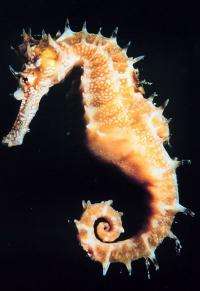January 27, 2011 report
How the seahorse might have got its shape

(PhysOrg.com) -- The shape of the seahorse has long baffled marine scientists, but new research suggests the seahorse’s unique shape may have evolved to allow it to catch its food when it was further away.
Researchers, led by biomechanicist Dr. Sam Van Wassenbergh of the University of Antwerp in Belgium, wondered why the seahorse shape, consisting of a curled tail and striking arched head is so different from that of its relative, the pipefish, which is long, thin and straight like the ancestors of the seahorse.
The scientists used a biomechanical analysis technique to study the shape and posture of the seahorse and pipefish and discovered that the seahorse can capture its prey of small shrimps and fish larvae at a greater distance from the eyes than the pipefish. They confirmed the mathematical analysis and computer animations with high-speed video footage of both types of fish in action.
Dr. Van Wassenbergh said the "bend and snap" technique used by the seahorse is vital for a species that is a weak swimmer because every extra millimeter means more food. He said the technique gives the seahorse a 20 percent larger strike zone than the pipefish.
The pipefish swims around to catch its prey, and when prey is in sight it lifts its head slightly upwards and forwards to get its mouth close enough to suck the prey inside. The seahorses have an additional forward reaching component with its head (which is arched), meaning it straightens its neck to lift its head upwards, and so it can reach slightly further. This enables the seahorse to probe a larger volume of water for food while it waits for the prey to swim by, remaining stationary and with the tip of its tail attached to sea grass.
Dr Van Wassenbergh said the foraging behavior would have come first and then natural selection would favor those fish that had a larger strike distance. According to their research this created a selective pressure for the angle between head and trunk to increase.
The paper was published in the journal Nature Communications.
More information: An adaptive explanation for the horse-like shape of seahorses, Nature Communications 2, Article number: 164 doi:10.1038/ncomms1168
© 2010 PhysOrg.com

















